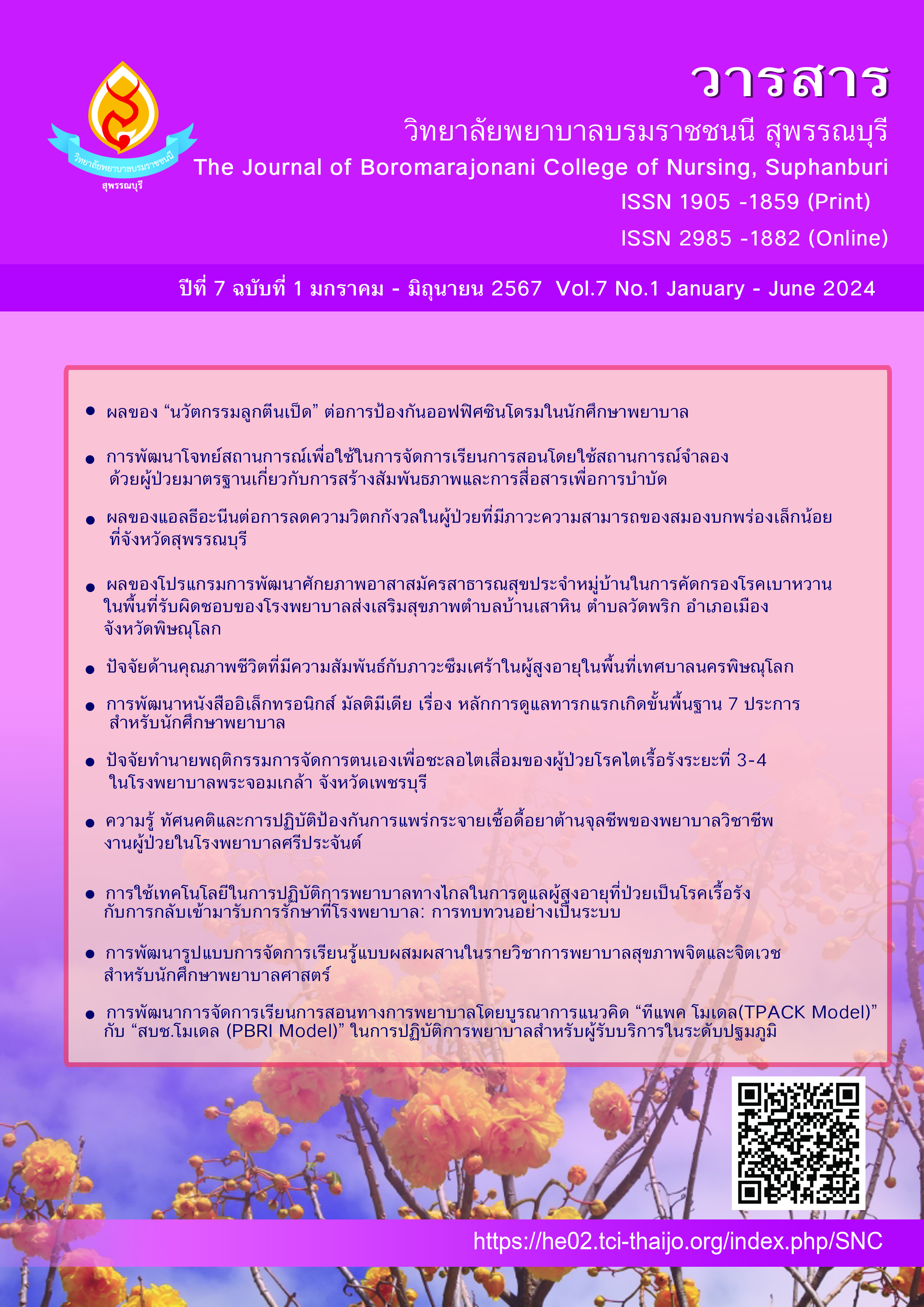The Development of Blended Learning Model in Mental Health and Psychiatric Nursing for Student Nurse
Keywords:
mental health and psychiatric nursing subject, blended learning, programAbstract
This research and development aimed to study blended learning model in mental health and psychiatric nursing for student nurse. The sample of 104 second-year nursing students, academic year of 2021, enrolled in mental health and psychiatric nursing subject was purposively selected from Boromarajonani College of Nursing, Surin. The instruments used were divided into 3 parts. The first one was 1) the blended learning program, 2) the questionnaires such as the mental health and psychiatric nursing achievement test, the psychiatric nursing practice competency questionnaire. The content validity Index was verified by 3 experts. The reliability of questionnaire was 0.96, 0.82. The data was analyzed by percentage, mean, standard deviation, and paired t-test.
Results showed that the effective blended learning model of adult nursing 1 subject by using carmen concept (2005) consist of 40 % of lectured participation and 60% of leaning from media online by teacher synchronous with student in the same time, online changing opinion 2. Google classroom 3. Case study analyze and development mental health and psychiatric nursing process by using evidence base practice 4. Quit test midterm and final test 5. Self study with online data base. When comparing of the psychiatric nursing practice competency, psychiatric nursing achievement test, it is found that 1) the nursing students had a statistically significant higher score of the psychiatric nursing practice competency after using the blended learning (P<.05), 2) the nursing students who pass had the mental health and psychiatric nursing achievement test more than 60 %, the highest score is final test (91.35%; n=95) then, midterm test (76.08% (n=79)
In conclusion, the blended learning program can enhance knowledge and psychiatric nursing practice competency in student nurses. Therefore, teacher should be use the blended learning for preparing mental health and psychiatric nursing practice.
References
กัลยาณี ตันตรานนท์, วิลาวัณย์ เตือนราษฎร์และธานีแก้วธรมา.(2561).การประยุกต์ใช้แนวคิดการจัดการเรียนรู้แบบผสมผสานในกระบวนวิชาวิทยาการระบาด.พยาบาลสาร, 45(1), 100-109.
กลุ่มวิชาการ. (2564). รายงานการประเมินผลการจัดการเรียนการสอน. วิทยาลัยพยาบาลบรมราชชนนี สุรินทร์. สถาบันพระบรมราชชนก กระทรวงสาธารณสุข.
ปิยนุช ชูโต,ศรีมนา นิยมค้าและจันทร์ฉาย โยธาฤทธิ์. (2557). ผลการจัดการเรียนการสอนแบบผสมผสานเพื่อเสริมสร้างสมรรถนะทางเทคโนโลยีสารสนเทศเพื่อสนับสนุนการฝึกปฏิบัติการพยาบาลของนักศึกษาพยาบาลศาสตร์ ชั้นปีที่ 4 มหาวิทยาลัยเชียงใหม่. วารสารพยาบาลและการศึกษา, 7(4), 156-167.
ธิดารัตน์ คณึงเพียร. (2564). มคอ 3 วิชาการพยาบาลสุขภาพจิตและจิตเวช. วิทยาลัยพยาบาลบรมราชชนนี สุรินทร์. สถาบันพระบรมราชชนก กระทรวงสาธารณสุข.
ไพรวัลย์ โคตรตะ, สุวิมล โพธิ์กลิ่นและ อภิชัย กรมเมือง. (2560). อนาคตภาพของการจัดการศึกษาหลักสูตรพยาบาลศาสตรบัณฑิตในบริบทประชาคมอาเซียน. วารสารวิจัยทางวิทยาศาสตร์สุขภาพ, 11(2), 18-27.
สุสัณหา ยิ้มแย้มและคณะ. (2558). การพัฒนาการจัดการเรียนรู้แบบผสมผสาน เพื่อพัฒนาทักษะการเรียนรู้ในศตวรรษที่ 21. พยาบาลสาร, 42 (ฉบับพิเศษ), 129-140.
วิภาดา คุณาวิกติกุล. (2553). การเรียนการสอนสาขาพยาบาลศาสตร์ ในยุคศตวรรษที่ 21. พยาบาลสาร,
อติญาณ์ ศรเกษตริน สุทธานันท์ กัลกะ ทัศนีย์ เกริกกุลธร อัจฉราวดี ศรียะศักดิ์ อัจฉรา สุขสำราญ. (2566)การจัดการเรียนการสอนทางการพยาบาลในช่วงสถานการณ์การแพร่ระบาดของโรคติดเชื้อไวรัสโคโรนา 2019. ราชาวดีสาร, 13(2), 149-164.
อรวรรณ จุลวงษ์ พจนา เปลี่ยนเกิด สมพิศ เกิดศิริ และ อัญธิดา สระแก้ว. (2556). การสร้างเครื่องมือวัดสมรรถนะการปฏิบัติการพยาบาลจิตเวชของนักเรียนพยาบาลกองทัพบก. วารสารพยาบาลทหารบก, 14(3), 50-8.
COMAS-QUINN, A. Learning to teach online or learning to become an online teacher: an exploration of teachers’ experiences in a blended learning course. European Association for Computer Assisted Language Learning, 23(3), 218–232. .doi.org/10.1017/S0958344011000152,
Carman, J.M. (2005). Blended Learning Design: Five Keys Ingredients. http://www.agilantlearning.com/pdf/Blended%20L.pdf.
Gagnon, M., Gagnon,J., Desmartis, M and Njoya M. (2013). The Impact of Blended Teaching on Knowledge, Satisfaction, and Self-Directed Learning in Nursing Undergraduates: A Randomized, Controlled Trial. Nursing Education Perspectives, 36 (4), 377-382.
Jeffrey, L. M., Milne, J., Suddaby. G., & Higgins, A. (2014). Blended learning: How teachers balance the blend of online and classroom components. Journal of Information Technology Education: Research, 13, 121-140. Retrieved from http://www.jite.org/documents/Vol13/JITEv13ResearchP121-140Jeffrey0460.pdf
Jokinen, P., & Mikkonen, I. (2013). Teachers' experiences of teaching in a blended learning environment. Nurse education in practice, 13(6), 524–528. https://doi.org/10.1016/j.nepr.2013.03.014
Downloads
Published
Issue
Section
License
Copyright (c) 2024 Boromarajonani College of Nursing, Suphanburi

This work is licensed under a Creative Commons Attribution-NonCommercial-NoDerivatives 4.0 International License.
บทความที่ได้รับการตีพิมพ์เป็นลิขสิทธิ์ของวารสารวิทยาลัยพยาบาลบรมราชชนนี สุพรรณบุรี
ข้อความที่ปรากฏในบทความแต่ละเรื่องในวารสารวิชาการเล่มนี้เป็นความคิดเห็นส่วนตัวของผู้เขียนแต่ละท่านไม่เกี่ยวข้องกับวิทยาลัยพยาบาลบรมราชชนนี สุพรรณบุรี และคณาจารย์ท่านอื่นๆในวิทยาลัยฯ แต่อย่างใด ความรับผิดชอบองค์ประกอบทั้งหมดของบทความแต่ละเรื่องเป็นของผู้เขียนแต่ละท่าน หากมีความผิดพลาดใดๆ ผู้เขียนแต่ละท่านจะรับผิดชอบบทความของตนเองแต่ผู้เดียว



